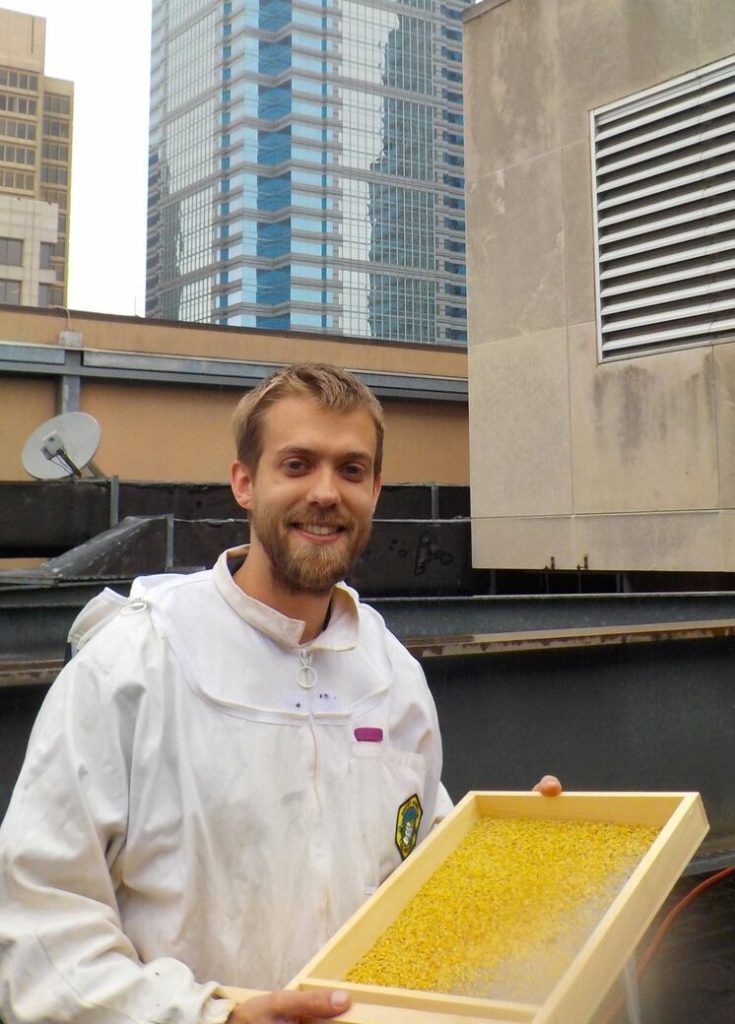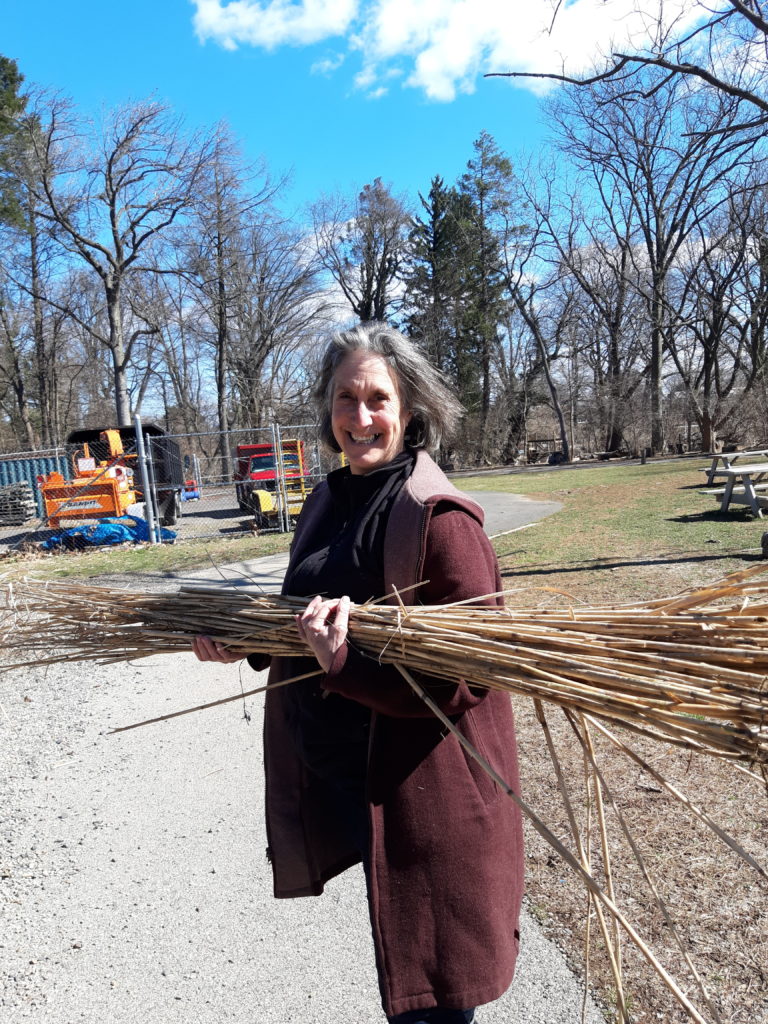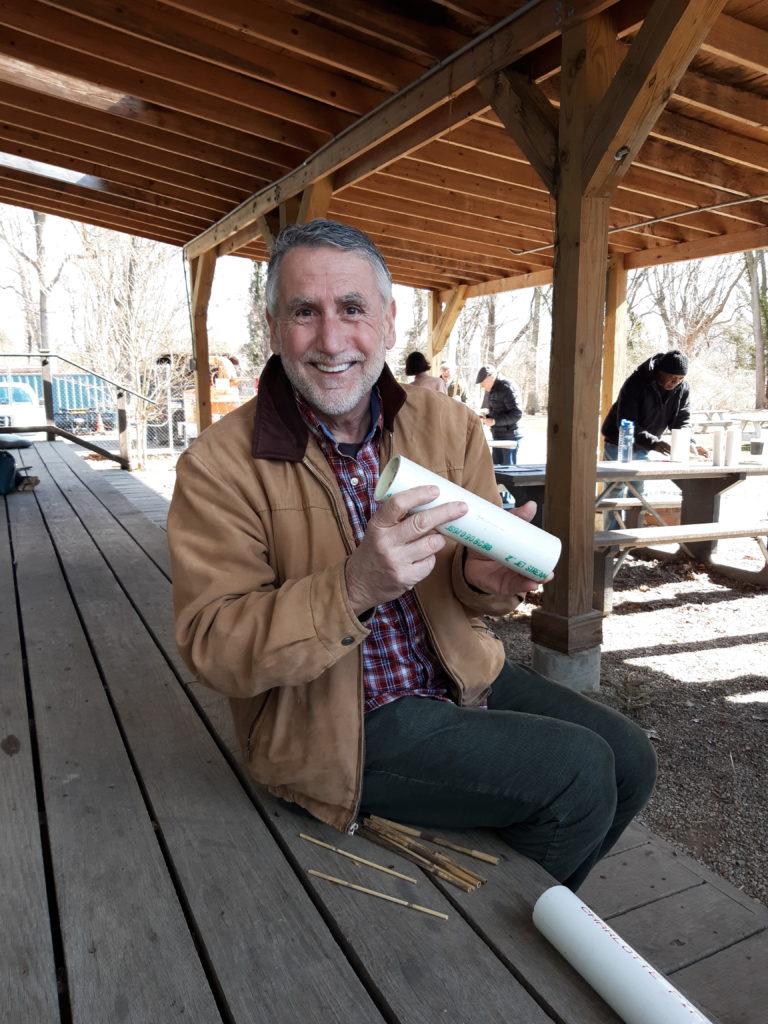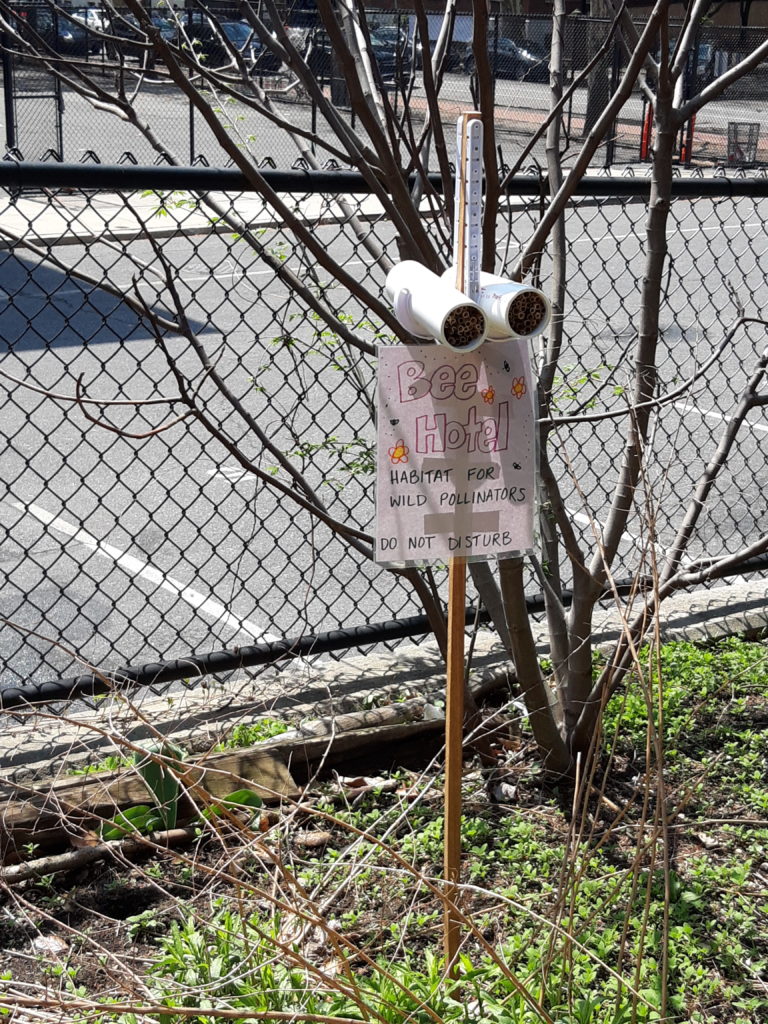During the third week of our 10-week research program with student researchers from Swarthmore, students interviewed experts and local community partners about what citizens could do to support pollinator habitat and populations in the city. This is an issue vital to POP, as nearly all of our fruit crops are dependent on insect allies like bees, butterflies, wasps, and moths for successful pollination and fruit production. For this reason, all POP orchards include pollinator gardens, often planted in the orchard understory.
Swarthmore student researcher Daria Syskine interviewed Dr. Doug Sponsler, postdoctoral scholar of the Penn State University’s Center for Pollinator Research, and a research associate at the Academy of the Natural Sciences at Drexel University. He received a PhD in entomology from Ohio State University. His current research focuses on the urban ecology of pollinators. As part of that research, he has been using citizen science – working with volunteers and members of the Master Gardeners program at Penn State to construct and collect data from bee hotels, which will house various wild stem-nesting bee species around the city.
Last March 2019, Sponsler led a bee hotel making workshop at Awbury Arboretum’s Agricultural Village. POP is fortunate to have 7 bee hotels placed with POP partners and community organizations including Bartram’s Garden, Overbrook School for the Blind, Elwyn Davidson School, Interpret Green, Richard Allen Preparatory Charter School, Penn Alexander School, Wissahickon Environmental Center. Partners at these sites have been photo-documenting the nests, including which tubes have been nested in by native bees, as well as the surrounding flora around these hotels. This information is being compiled city-wide through Sponsler’s research.

Below is an interview with Dr. Doug Sponsler, conducted by Daria Syskine; the interview has been edited for length and clarity.
Syskine: What made you decide to study honeybees?
Sponsler: I saw pollination biology as an opportunity to study entomology in an ecologically integrative way, so it wouldn’t be an entomological cloister. […] I found the study of pollinators to be integrative in that it involves plants and animals, and is amenable to a lot of different techniques and perspectives. So that’s what drew me to bees. What drew me to honeybees was more of an accident – I ended up doing a doctoral program with a honeybee biologist, and so I originally was going to study non-Apis bees. Of the projects that I started, the one that stuck was a honeybee project. But I don’t regret that. I love honeybees, I think they’re a wonderful study system. […] [And] there’s a lot of practical beekeeping that goes into honeybee research. I love them for that reason, too – it’s not purely an abstract love of knowledge of honeybees, it’s that more first-hand appreciation for biology that comes from spending time with them. And it’s not always pleasant, of course – there’s some really bad days in the apiary when you get stung a lot, and it’s really hot and sticky. But I have never had more fun at work than I have doing beekeeping in Philadelphia.
One of your main research focuses is urban and agricultural landscape dynamics for bee foraging. Where does citizen science come into that?
Sponsler: […] What citizen science enables you to do is to scale a project up, because if I have to be personally in charge of administering a project at every site that it’s being conducted at, that really limits the number of sites I can have. If I can have people help me with it, then I can have as many sites as I have people willing to manage them for me. But I think citizen science should be more than that. It should be more than just a logistical convenience. […] So I expect people to be creatively involved, and I want to shape the project to their interests and their needs, and I’d like to try to direct projects in conversation with the people participating.

Tell us some more about your current project.
Sponsler: It’s a stem-nesting bee project. I’m targeting stem-nesting bees because I have a particular methodological approach that is only amenable to stem-nesting bees. I’m using what are sometimes called bee hotels […] it’s a bundle of hollow stems – for the stems I use Phragmites australis – I cut them into sections and pack them into PVC pipes and create a low-cost bee-nesting habitat that has been used pretty widely in the literature to attract the kinds of bees that will nest in hollow stems. Which will mostly be Osmia [mason bees], and some others, as well.

How have you been getting the community involved in this project?
Sponsler: Since I’ve been working here for a couple of years, I’ve been building up a network of connections with people who are interested in this sort of thing. I focused on working with the Philadelphia Master Gardeners program, the Philadelphia Botanical Club, and the Philadelphia Beekeepers Guild. And through those channels I’ve expanded into some groups, including the Philadelphia Orchard Project. […] I think it’s reasonable to expect that we’ll have over a hundred locations represented throughout the city. What I’m asking each participant to do is to tell me the location of each nest and the date of installation, and throughout the season I’m having them take a photograph of the front side and back side of the nest […] That will enable me to see on a monthly basis how many of them have been capped – when a bee has finished provisioning a nest, she will cap one end with mud or resin or leaf tissue. [W]e’ll be able to track the occupancy rate and how that changes through time, and which size tubes are being occupied, which will give us some guess of what kinds of bees might be in there. This will be the first time we’ve done this study, so we don’t know what to expect as far as size distribution. […] So we have a range of tube sizes in there and we’re going to see who shows up. At the end of the year – as I said, each unit consists of two pvc pipes stuffed with stems – in Philadelphia, I’m going to be sampling one of those PVC tubes is going to be destructively sampled at the end of the year, and the other will remain there and be allowed to emerge naturally in the spring.

Do community members get any training in bee identification?
Sponsler: I’m not asking people to identify bees, because bee identification is not trivial. […] However, I am encouraging people to spend time watching their nests and take pictures of the bees they see and post them on iNaturalist [a free app where professionals and amateurs identify organisms from photos]. I love iNaturalist, I’m a big advocate of it, and I would love to see people to get to know the bees in their backyards and their gardens, and to create an interface for familiarity and participation. […] I think you have to know the names of things before you can care enough to conserve them. I feel very strongly about that. [W]hat I’m doing here is not going to make a global conservation impact or something. But just the act of knowing the bees in their backyard, or of knowing anything in their backyard, is a good, worthwhile end. One of the other goods that I hope comes of it is some research I can publish, and I’m sure that will be the case. But in a way that’s almost a bonus to just getting people to be natural historians of their neighborhoods.
Your research has found that honeybees do better in agricultural landscapes than urban ones. Do you think programs like Philly Master Gardeners or the Philadelphia Orchard Project can have a significant impact on bee populations in cities?
Sponsler: I think there’s enormous opportunities to make cities much, much better for bees. Because so much of urban land is discretionary in how it’s used. In agricultural land, much of the land has to be used in certain ways, because the goal is to produce food. And if I’m growing corn, that field needs to grow corn. If I’m just a homeowner in a city, then within certain boundaries, I can do almost anything I want with my backyard, front yard, sidewalk strip. If I want to grow flowers instead of grass I can do that, as long as I maintain good relations with my neighbors. […] I would love to see every lawn in America torn up and replaced with flowers and food, because why not, right? We have land, let’s do something useful with it. And that’s gonna be a slow process, but something similar can be done with a lot of municipal rights-of-way – like roadsides, train tracks, power lines, things like that. Instead of having mowed grass in those places, you can have appropriate flowering plants. Grasses flower; or showy pollinator-attractive flowering plants. […] I think there’s a chance to make cities better than they are, and there’s more latitude in cities for how we can use the land than there is in more restrictive, functional landscapes.
And that’s where organizations like POP can come in.
Sponsler: Yeah. Pennsylvania Horticultural Society, and also the people actually making municipal land use decisions for the city as well – I’d like to eventually get the ear of people on City Council as well, and try to – within reason – make the city a more ecologically rich, functional place, where we can make easy decisions like mowing less frequently, planting flowers instead of grass.
So it all comes back to getting raising awareness about what people living in the city can do to improve habitat for bees.
Sponsler: I think it’s important not to exaggerate the importance of specifically urban bee conservation. [B]y and large what you get in cities is an enrichment of certain common exotic species, with occasionally native species showing up, too. I don’t think global biodiversity is going to be saved by what we do in cities. But I think urban biodiversity will. And I think indirectly, we can cultivate a culture in which biodiversity is valued by preserving the interface between people and nature in the cities, because it is where most people live, and it is the culture of cities that drives large-scale decisions on policy. And if in these population centers we cultivate a sensitivity towards biodiversity, then that will be instrumental in conservation, I think. [S]omething does not have to be global in scale to be valuable, and I think even if all I could do was to make Philadelphia more bio-diverse and beautiful and functional, and create space for people here to learn and appreciate the biodiversity of their neighborhood, then that’s a satisfactory good in itself. Because that’s the kind of city I want to live in, and it’s the kind of city I’d like to live in, too.
This POP Blog Post prepared by 2019 Swarthmore student researcher Daria Syskine with support from POP Education Director Alyssa Schimmel.
SUPPORT US! If you found this entry useful, informative, or inspiring, please consider a donation of any size to help POP in planting and supporting community orchards in Philadelphia: phillyorchards.org/donate.